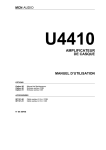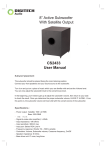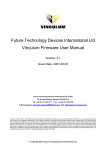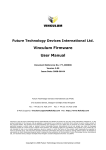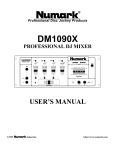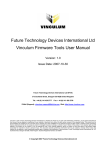Download DJ - STAR
Transcript
DJ - STAR TABLE DE MIXAGE NOTICE D’UTILISATION FACE SUPERIEURE 1 – INTERRUPTEUR DE MARCHE/ARRET 2 – CUE LEVEL : Contrôle du volume du casque. 3 - BOUTON « GAIN » : Ils permettent le réglage du gain d’entrée de chaque voie. 4 – CONTROLE DU VOLUME DE CHAQUE VOIE : Fader stéréo de réglage du niveau. 5 - PRISE « PHONES » : Permet de brancher un casque stéréo. 6 – TALK OVER : Lorsque cet interrupteur est en position « ON » on atténue de 12dB le signal sortie de la voie 1 & 2 (CH 1 – CH2) 7 – DJ MIC : Réglage du niveau de la voie micro DJ sur la sortie MASTER. 8 – SELECTEUR D’ENTREE : Vous pouvez sélectionner le signal d’entrée avec ces commutateurs (LINE 1/PHONO 1 – LINE 2 / PHONO 2). Exemple : pour un CD le commutateur doit être en position LINE 9 – VUE METRE A LED DE LA SORTIE MASTER : Le niveau de sortie de la table de mixage est visualisé à l’aide du vue mètre à LED. 10 – SELECTEUR CUE : Commutateur de pré écoute. 11 - CROSSFADER AMOVIBLE : Ce crossfader très doux permet un changement de voix très rapide entre la voie 1 et la voie 2. 12 – ENTREE MICRO DJ : Prise Jack 6,35 asymétrique pour brancher le micro. FACE ARRIERE 13 – ENTREES PHONO ASYMETRIQUES : Ce sont des entrées jack RCA spécialement étudiées pour être utilisées avec des cellules phono magnétiques. Aucun autre appareil ne peut être utilisé avec cette entrée. 14 - ENTREES LINE/CD ASYMETRIQUES : Ce sont des entrées Jack RCA qui doivent être connectées à tout type de lecteur avec un niveau de sortie LINE (magnétophone, lecteur CD, tuner, video, instrument de musique). 15 – CONNECTEUR D’ENREGISTREMENT : Cette sortie de niveau LINE est à relier à tout système d’enregistrement (CASSETTE, DAT, DCC…). Cette sortie ne dépend pas du réglage « MASTER ». 16 – SORTIE MASTER : Prises Jack RCA asymétriques de faible impédance, les faders CH 1 ou 2 règlent le niveau de sortie. 17 – PRISE AC 12V : Alimentation secteur. Cette table de mixage est alimentée par un transformateur extérieur. SPECIFICATIONS TECHNIQUES Sensibilité d’entrée MIC PHONO LINE 1 mV / 600 ohms 3 mV / 51 K ohms (RIAA) 150 mV / 100 K ohms MASTER REC PHONES 0.775 V / 600 Ohms 0.38 V / 600 Ohms 100 mV / 100 K Ohms Niveau de sortie (maxi 4V) Réponse en fréquence 20 Hz~ 20 KHz ±1dB (RIAA ±2dB) Distorsion harmonique totale <0.1 % Séparation des canaux >45 dB Rapport signal/bruit MIC PHONO LINE 70 dB 70 dB 75 dB Réduction Talk Over - 12 dB Dimensions 200 x 166 x 80 mm Poids 2 Kg Owner’s Operating Manual Professional Stereo Sound Mixer Please read before using this equipment 430 Front Panel 1. POWER Switch: This switches the AC power to the mixer ON or OFF. Note: Be sure to switch on the power to your mixer before switching on the amplification system. 2. CUE Level Control: This control varies the volume in your headphones, the volume of the signal heard through the headphones. 3. GAIN Controls: Correct setting of the controls for input GAIN for every channel is crucial for getting a good, strong signal without noise or distortion. 4. Channel Level Control: The channel fader adjusts the overall volume of the channel. The faders of the stereo channels control both left and right signal at same time. 5. PHONES: This is a 1/4” stereo jack socket mounted on the bottom side of the mixer for you to attach your headphones. 6. TALK OVER Switch: With this switch engaged the main music program will be attenuated by 12dB when the mic is active. 7. Microphone LEVEL Control: Controls the overall level of the DJ Microphone being mixed onto the Master outputs. 8. Input Selector: Each music input channels has two input options. This switch lets you select which of the inputs plugged into the channel you wish to use. All input channels are dual with Channel PHONO/LINE1, Channel PHONO/LINE2 (CD is a line level source). 9. MASTER OUT Display: The output level of the mixer is shown in the MASTER OUT display. 10. CUE Selector: This control selects the input signal on the respective channel and routes it to the headphones output. 11. Replaceable Crossfader: This dipless horizontal slider provides clean segues between the sources on channel 1 and channel 2. This allows for effortless crossfading between the 1 and 2 side of the crossfader. 12. DJ Microphone Input: An unbalanced 1/4” jack socket is mounted on the bottom face of the mixer for connecting your microphone. Rear Panel 13. PHONO Inputs: These inputs are unbalanced RCA jacks. Use these only for turntables with moving magnet cartridges. Line level sources will overload these inputs. Moving coil cartridges require a separate head amp for optimum sound. 14. LINE/CD Inputs: These inputs are unbalanced RCA jacks, connect stereo audio from Hi Fi VCRs, cassette and reel-to-reel tape decks, CD players, VDPs, Tuners, even synthesizers or other mixing consoles. 15. RECORD Outputs: This outputs is used for additional feed to such items of equipment as tape records. The output level of the signal is not affected by the Master Level control. 16. MASTER Output: There stereo outputs are low impedance, unbalanced RCA jacks, the output level is controlled by the Master fader. 17. AC Supply Socket: This mixer is supplied with an external AC power supply unit. SPECIFICATIONS: Input Sensitivity/ Impedance: MIC 1mV / 600 Ohms PHONO 3mV / 51KOhms (RIAA) LINE 150mV / 100KOhms Output Level/ Impedance: MASTER (Max. Output: 4V) 775mV/600Ohms REC 380mV/600Ohms PHONES 100mV/8Ohms Frequency Response: 20Hz~20KHz ±1dB (RIAA ±2dB) Total Harmonic Distortion: Less than 0.1% Stereo Separation: More than 45dB Signal-To-Noise Ratio: MIC 70dB PHONO 70dB LINE 75dB Talkover Reduction: -12dB Dimensions: 200mm* 166mm* 80mm Weight 2 kg














